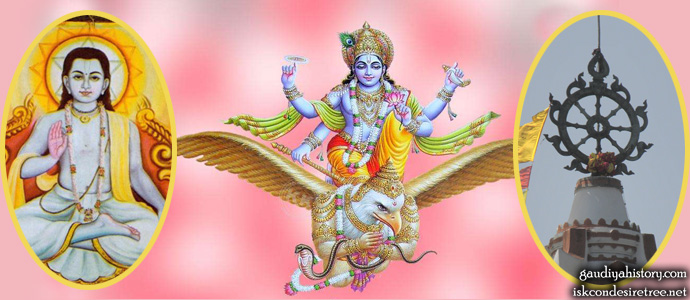The main exponent of the Kumara or Chatuhsana sampradaya (this knowledge was transmitted to the four Kumaras by the Hamsa avatara), who lived in the 13th century and propagated the doctrine called dvaita advaita, "simultaneous oneness and duality".
Shri Nimbarkacharya is believed to be the incarnation of the Sudarshana Chakra (the Discus weapon of Krishna)
At the end of Treta Yuga, the Brahmanas, being afraid of the Asuras, prayed to Lord Hari. They also prayed to Brahma who himself prayed to Lord Hari again. Then the Lord summoned his own Sudarshana Chakra -a part of Himself- and commanded him to descend on earth to revive and teach the Vaishnava Dharma which was waning and which he could learn from Narada, and spread it all around.

Shri Nimbarkacharya is believed to be the incarnation of the Sudarshana Chakra (the Discus weapon of Krishna) (In the wallpaper: in the middle Lord Shri Vishnu on Garuda, Sudarshana Chakra of Lord Jagannath Temple, Puri, Shri Nimbarka Acharya in the left).
The incarnation of the Sudarshana Chakra occurred, according to the Bhavishya Purana in the month of Kartika on the evening of the full moon in the year 3096 BCE. His mother, Jayanti and father, Aruna were Tailanga Brahmanas, who resided on the banks of the river Godavari at a place known as Telinga, the modern Vaidurya Pattanam in Andhra Pradesh. He was named Niyamananda at birth. The region was famed for its scholarly learning, and by the age of 16, Niyamananda had mastered the Vedas and all related philosophical scripture. With the permission of his parents, Niyamananda then embarked on a search of a true Guru. Upon reaching Govardhan in Mathura, Uttar Pradesh, he began practising penance under the shade of Neem trees. Pleased with his penance, the Sage Narada blessed him with the knowledge of true Vedanta, the doctrine of Dvaitadvaita – or unity in duality. After this, Niyamananda begged Narada to accept him as a disciple. The great sage Narada gave him initiation according to Vaishnava rites, and bestowed him the Shalagrama Deity known as Shri Sarveshvara (the Lord of All). Continuing, Narada renamed him Haripriya (one dear to the Lord). He then instructed Niyamananda on the Gopala Mantra of the Gopalatapini Upanishad. Once completed, the Sage Narada instructed him to practise further penance with that Mantra and all will be revealed before leaving.
In the ritual recitation and meditation upon that mantra, the Lord revealed Himself as Shri Radha-Krishna. Niyamananda worshipped them, and was blessed with the recollection of his former glory as the Sudarshana Chakra of that very Lord. The Lord instructed him to teach this philosophy to all, and departed.
In a famous incident, having established his ashrama (monastery/hermitage) at that place near Govardhan now known as Nimbagrama, Niyamananda began to teach the disciples who dedicated themselves to his mission. Brahma disguised himself as a renounciate and ventured to this hermitage just before sunset, where the two engaged in philosophical debate. Niyamananda, being victorious, then offered the guest some refreshments, but he refused, as the sun had set and it would be against the rules of the renounciates. Niyamananda had to make sure the renounciate ate, otherwise the rules of receiving a guest would be broken. The enlightened Niyamananda projected some of the effulgence of his being over the neem trees and the renounciate agreed to accept the refreshment. Thereafter, Brahma revealed himself and blessed him on his knowledge of the Supreme, and gave him a new name – Nimbarka, the one who has placed the Sun in the midst of the Neem trees.
It is with this name that he became famous, though his exact date of death is not known. His disciplic tradition continues unbroken till today, however the information regarding the leaders between leaders 12 and 13 is lost; amongst which were many hundred leaders, due to interference from foreign invaders.